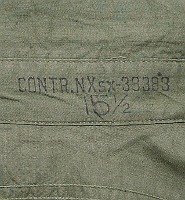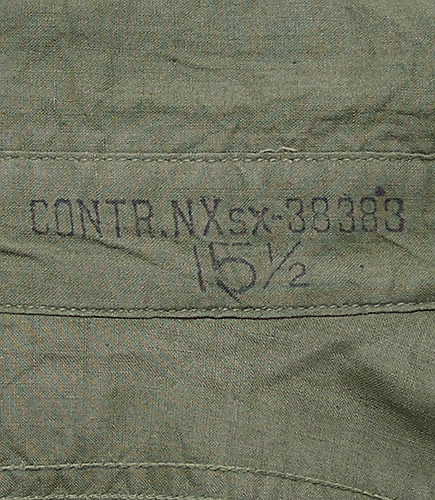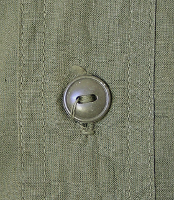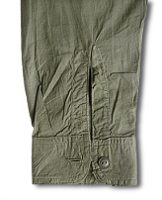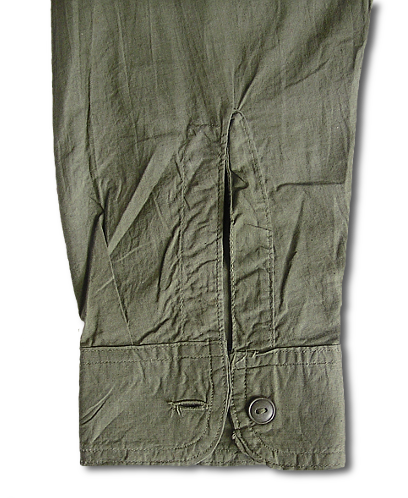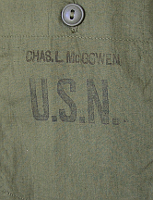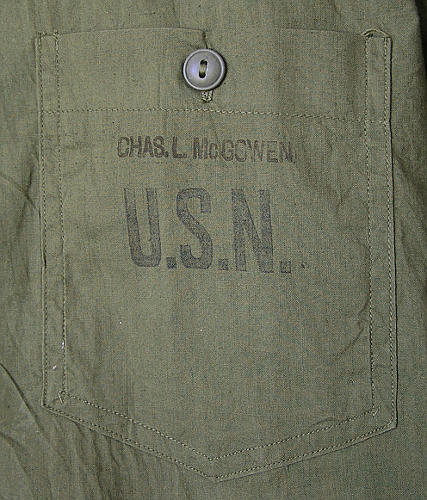U.S. Navy Men's Shirts
Utility Shirt Type N-3

Specification 55-S-23
The N-3 shirt was part of a 4-piece utility uniform issued to U.S. Navy ground personnel. Recipients of the N-3 utility uniform included shore parties, construction battalions, amphibious units, combat, and security units. Utility shirts were an individual allowance for personnel serving at overseas bases. Three utility shirts were issued to eligible personnel assigned to bases located in temperate, tropical, or cold climates.
| Key Visual ID | Primary Materials | Fasteners | Color | Labeling |
| Dark Olive Drab Shade 7 color. "USN" ink stamp present on left breast pocket. Design resemblance to the blue chambray shirt. | Lightweight, plain weave, cotton broadcloth. | The shirt used 10 two hole plastic buttons. Six were utilized for the front closure, one button for each sleeve cuff, and one button for each pocket. | Olive drab shade 7. | Contract and size information was ink stamped to the inside of the collar. |
| Treatments | Approx. Contract Run | Preceded By | Replaced By | Companion Garments |
| Prior to assembling uniforms, cotton material was Sanforized as part of the manufacturing process to prevent shrinkage of the finished product. | July 1943 to April 1945. | Blue Chambray Shirt. | Unknown. | N-3 Utility Trousers. N-3 Utility Jacket. N-3 Utility Cap. N-1 Field Shoes. |
(touch or point mouse at picture for expanded view)
|
By the spring of 1943 the Navy had developed a new and improved line of special and protective clothing. Items were given an alpha numeric nomenclature of N-1, N-2, or N-3. The new issues included wool and wool lined winter wear, protective rain wear, and warm weather utilities. Special and protective clothing types were to be issued according to job function and weather conditions. Sizing was roomy allowing garments to be layered over one another in order to provide warmth, create a wind and water-proof "barrier", and at the same time allow flexibility of movement. New colors were introduced to provide better camouflage protection to forces deployed in combat zones. Instead of blue, black, white, and gray colors used in previous issues, the new garments would be either khaki, olive drab shade 7, or light green for items made of jungle cloth. Standard lists of outfits consisting of various "N" designated items were developed for issue to Navy ground personnel serving overseas in tropical, temperate, cold, and arctic regions. There was also a standard outfit list and allowance recommendations for personnel serving afloat. The utility shirt was included in the list of items assigned the N-3 nomenclature. A list of N-3 articles and corresponding specification numbers follow:
Specialized and protective clothing could be issued either as an individual allowance or unit allowance. Unit allowances were calculated as a percentage of the compliment of a particular base. For example, at an aviation base it was generally recommended that enough "N" class articles be ordered to outfit 30% of the personnel. Utility uniforms were issued as an individual allowance to naval personnel serving ashore at overseas bases. The various components of the utility uniform were issued to the individual in the following quantities:
Utilities were issued in cold, temperate, and tropical climates. Some examples of units that received N-3 utility uniforms include Construction Battalions, Amphibious Forces, and Beach Parties. Prior to developing improved versions of its special and protective clothing, the Bureau of Yards and Docks was outfitting its ground personnel with Army herringbone twill designs. One-piece Army work suits and slightly modified Army two-piece suits were issued for chore work and hot weather field use. In 1943, the Navy approved a new multi-piece utility uniform to replace the Army types it was using. This time, instead of an Army design, the Navy patterned the new utility jacket and trousers on the Marine Corps' M-1941 utility uniform then in use. In addition to the jacket and trousers, both a lightweight broadcloth shirt and a baseball-style herringbone twill cap were developed to complete the new outfit. The Army and Marine Corps' early HBT uniforms were, out of necessity, pushed into the combat role by the sudden onset of war. |
Evaluations of the early HBT uniforms led to improvements in subsequent issues. One area identified for immediate improvement was the need for better camouflage concealment in the jungle terrain of the South Pacific. In response, the Marine Corps opted to issue camouflage patterned utilities in 1942. After experimenting with a camouflage one-piece jungle suit in 1942, the Army approved the use of a darker shade of material in its standard HBT uniforms in the spring of 1943 . Though the Army continued to develop different types of camouflage uniforms, the darkened 2-piece HBT uniform would remain its standard issue hot weather combat field uniform throughout the war. At this time, the Navy also chose to produce their new utility uniform in the dark green olive drab shade 7 color. Army testing and reports from the field eventually revealed that a single dark shade of olive drab offered better overall camouflage properties in jungle environments than did various patterned designs. As a result, in the fall of 1944, 8.5 ounce, olive drab shade 7, herringbone twill material was standardized for use in Army and Navy utility uniforms (See joint Army-Navy specification JAN-C-154, Cloth, Herringbone Twill, dated 30 November 1944). The Navy's N-3 utility uniform differed from its Army and Marine Corps cousins by including a shirt specifically designed to be worn with the herringbone twill jacket and trousers. Inclusion of shirt was consistent with earlier Navy developments such as the blue denim working uniform, which included the blue chambray shirt.
Design of the N-3 shirt was taken directly from the pattern of the blue chambray shirt. This was a logical choice by the Navy as it took advantage of an existing successful design while avoiding the expense of drawing up a new pattern and industry having to reorganize for a new design. Both shirts made use of light weight cotton fabric that was matched to the color of its parent uniform. With exception of color, all major design features, such as cuffs, use of a front button placket band, button type, and pocket type was identical to both shirts.
The N-3 shirt was constructed using a light, plain weave, cotton broadcloth material in the 4 to 5 ounce range. Regulations provided that the N-3 shirt could be worn without the jacket in such climates where the jacket was not needed. This provision afforded the sailor with a much cooler alternative to the herringbone twill jacket in the sweltering regions of the Pacific theater. Like the utility coat, the shirt was to be stamped on the left chest pocket with a "U.S.N." identifying mark. These stamps were applied in ink with font styles varying. Regulations stated that the sailor's name was to be stenciled above this same left breast pocket. As with many items manufactured during the WWII era, large quantities of N-3 shirts remained in surplus after the war. N-3 shirts were again issued to Navy ground forces in the Korean conflict and yet again in Southeast Asia. Some N-3 shirts from the Vietnam era can be found with Army insignia attached - no doubt a testament to the comfort the lightweight shirt provided in hot conditions. Occasionally shirts can be found with shortened sleeves; this seems to have occurred mostly in the Vietnam era. No major design changes have been noted with this shirt. Variations were minor and are attributed to manufacturer differences in the shaping of the bottom of the pockets, with some having a pointed bottom while others are rounded. As with most items variation can be found in the color of the buttons. |
